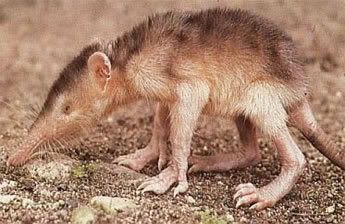
"For every action there is an equal and opposite reaction" Newton said once - although apparently he said something far more complex, but was probably babbling after getting brained by that apple. There are similar sayings and philosophies, like that credit card advert where someone does something clever so around the world another person has to be stupid to act as a counterbalance. Basically, it seems whenever anything good happens, there could well be a bad turn around the corner. Only a few months ago, I brought you the story* of the Cypriot Mouse, a brand new species of mammal discovered in Europe. It may have escaped your attention over the festive period, but recently we lost a species of mammal - albeit from slightly further afield.
The 2006 Yangtze Freshwater Dolphin Expedition travelled almost 4,000 miles in two weeks along the Chinese river, with monitors constantly scanning the yellowy water for one of the animals, known in Wuhan as Baiji. But they didn't find any. The co-leader, a Swiss scientist called August Fluger, said afterwards "We have to accept the fact that the Baiji is functionally extinct". Under the gaze of the world's cameras, a species vanished. River dolphins have slipped through the murky waters of eastern China for 20 million years, and have now become arguably the first large mammal species eradicated by human activity in the modern era (that we know of), especially when as recently as 1980 there were over 400 in the very same river. There are four other species of freshwater dolphins in the world, all critically endangered.
This brings me to a list. The Zoological Society for London (ZSL) have recently launched a new organisation called EDGE of existence, with a remit to '...conserve the world's most Evolutionarily Distinct and Globally Endangered (EDGE) species by implementing the research and conservation actions needed to secure their future'. By sending scientists to work with local experts and wildlife students in the countries where these species live, they can hopefully give these amazingly rare animals more of a chance. You, the public, can donate money to schemes to help the creatures and the students involved. Targeting individual types of fluffy things designed to appeal isn't new in conservation - but EDGE are doing things slightly differently, in that the things they are after might be fluffy, but most of them sure aren't cute.
The New Guinea Big-Eared Bat is one of them, and it may be too late for them as well. EDGE have released a list of the 100 most critically endangered mammals in the world, with the Baiji an unfortunate (and now possibly absent) number one. The NGBEB hasn't been seen since 1890, when an enthusiastic collector bagged 45 at once, and may have destroyed an entire species in one field trip. The top, or as it should probably be - bottom - 100 mammals left may be only 95 at the moment, the Vietnamese Leaf-Nosed Bat hasn't been seen for 60yrs, and is only known from a single individual. EDGE use an interesting system to work out which animals to concentrate on - those that are ecologically distinct or unique and are on the IUCN Red List, so putting more emphasis on unusual species.
Of course, the Giant Panda and Blue Whale are featured, but then also are such incredible oddities as the Handley's Slender Mouse Opossum, which is so rare there's no picture of it, and scientists don't know exactly where it lives, what it eats, or how it reproduces. Apparently it's quite slim, though. What about the Senkaku Mole? Confined to a single 4km island, they were only discovered in 1991, and are currently under threat from 300 goats trampling their burrows. The undoubted cutest of the lot, is the Long-Eared Jerboa, but there are other things with wierd and wonderful names, like the Hainan Gymnure, the Dinagat Moonrat, and the Hispaniolan Solenodon.
Predicatably because they sound strange, and look strange, most of them are incredibly strange. The solenodon (of which there are two in the top five) resembles 'a scruffy overgrown shrew' and produces toxic saliva that it injects through snake-like grooved fangs. The Sumatran Rabbit is so rare that locals don't have a name for it in their own language - which must present a problem to visiting well-meaning biologists. The Golden Bamboo Lemur exists solely on poisonous bamboo shoots, consuming 12 times the lethal dose of cyanide for most other mammals every day. The Volcano Rabbit rather unfortunately lives only on the slopes of lava-spewing mountains on the outskirts of the food-deprived population of Mexico City. I could go on. These things are incredible, and need your support. Who would want to live in a world without scruffy killer shrews and volcanic bunnies?
*Or I read it somewhere and quickly re-hashed it
EDGE of existence 100 List
Zoological Society for London
2006 Yangtze Freshwater Dolphin Expedition